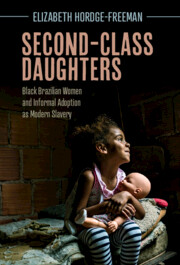Book contents
- Second-Class Daughters
- Afro-Latin America
- Second-Class Daughters
- Copyright page
- Dedication
- Contents
- Figure
- Acknowledgments
- Introduction
- 1 Adopting Modern Slavery
- 2 “Quase da Família” (Almost Family)
- 3 Prisoners of Love
- 4 Depths and Debts of Gratitude
- 5 Family Bonds and Bondage
- 6 Home Sick
- 7 Freedom to “Live Her Own Liberty”
- Conclusion
- Book part
- Works Cited
- Index
1 - Adopting Modern Slavery
Pathways into and Discourses of Criação
Published online by Cambridge University Press: 10 March 2022
- Second-Class Daughters
- Afro-Latin America
- Second-Class Daughters
- Copyright page
- Dedication
- Contents
- Figure
- Acknowledgments
- Introduction
- 1 Adopting Modern Slavery
- 2 “Quase da Família” (Almost Family)
- 3 Prisoners of Love
- 4 Depths and Debts of Gratitude
- 5 Family Bonds and Bondage
- 6 Home Sick
- 7 Freedom to “Live Her Own Liberty”
- Conclusion
- Book part
- Works Cited
- Index
Summary
In Chapter 1, the author highlights the structural factors (racism, sexism, poverty, rural residence) and individual-level traumas (abuse and violence) that precipitate young destitute girls’ entrance into criação. In doing so, she discusses how the prevalence of paternalistic views about Black families and the system of favors legitimates the adoptive family’s efforts to reframe exploitation as altruism or philanthropy. She highlights the disparate trajectories of the respondents by emphasizing the varying conditions and diverse forms of poly-victimization that drive their transfer into criação. The chapter dispels dominant myths that either demonize or romanticize criação in exchange for a more nuanced, even if uneasy analysis of the structural and individual factors that precipitate criação.
- Type
- Chapter
- Information
- Second-Class DaughtersBlack Brazilian Women and Informal Adoption as Modern Slavery, pp. 36 - 57Publisher: Cambridge University PressPrint publication year: 2022

